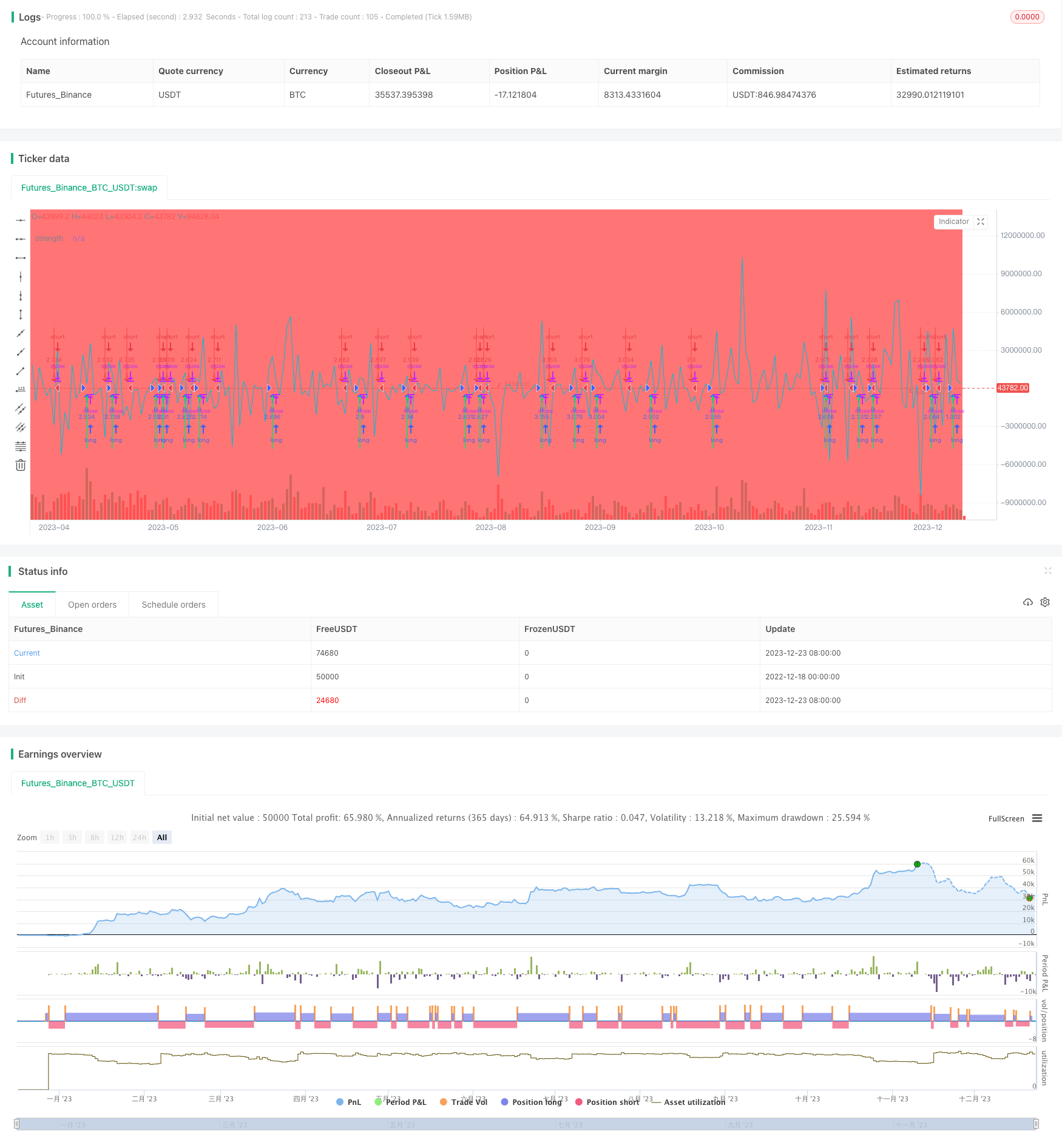
概述
该策略运用动量指标追踪短期价格变动,判断市场趋势方向,进行买入和卖出操作。策略名称为“Price Volume Trend Strategy”,反映了策略运用价格变动和成交量变动判断趋势的思路。
策略原理
该策略首先计算价格的动量。通过计算当前周期价格较上一周期价格的差值,可以反映最新一个周期内价格的绝对变动。正值表示价格上涨,负值表示价格下跌。然后计算这个差值的移动平均值,滤波处理,得到平均动量指标。
当最新价格大于平均动量时,表示价格在上涨;当最新价格小于平均动量时,表示价格在下跌。根据这个指标判断价格趋势方向。结合成交量放大过滤,实际交易中只选择成交量较大的信号。
根据判断出的价格上涨和下跌趋势,进行相应的买入和卖出操作。
优势分析
- 策略判断趋势迅速,能快速捕捉短期价格变动,适合短线操作
- 通过成交量过滤,避免被虚假突破误导
- 实现了追涨杀跌的操作逻辑
- 交易频率高,适合积极的投资者
风险分析
- 容易受到市场异常波动的影响,存在一定的假信号风险
- 交易频繁带来的滑点风险
- 可能错过中长线趋势,长期盈利能力有待验证
优化方向
- 调整动量指标参数,优化判断效果
- 优化成交量过滤参数,提高信号质量
- 增加止损机制,控制单笔损失
- 结合更多因子判断,确保多因子驱动
总结
该策略overall通过动量指标追踪价格短期变动趋势,快速判断买入和卖出时机。优点是操作迅速,追涨杀跌;缺点是信号质量和长期盈利能力有待考量。通过参数调整、风控机制增强,该策略可以成为高频策略的重要组成部分,与其他低频策略组合使用。
策略源码
/*backtest
start: 2022-12-18 00:00:00
end: 2023-12-24 00:00:00
period: 1d
basePeriod: 1h
exchanges: [{"eid":"Futures_Binance","currency":"BTC_USDT"}]
*/
// This source code is subject to the terms of the Mozilla Public License 2.0 at https://mozilla.org/MPL/2.0/
// © russtic
//@version=2
strategy("HA smoothed eliminator v2 ",pyramiding=1, slippage=10, default_qty_type=strategy.percent_of_equity,
commission_type=strategy.commission.percent, commission_value=0.075, overlay=true,
default_qty_value=100, initial_capital=1000)
FromMonth1 = input(defval=1, title="From Month", minval=1, maxval=12)
FromDay1 = input(defval=1, title="From Day", minval=1, maxval=31)
FromYear1 = input(defval=2019, title="From Year", minval=2010)
ToMonth1 = input(defval=12, title="To Month", minval=1, maxval=12)
ToDay1 = input(defval=31, title="To Day", minval=1, maxval=31)
ToYear1 = input(defval=2020, title="To Year", minval=2010)
start1 = timestamp(FromYear1, FromMonth1, FromDay1, 00, 00)
finish1 = timestamp(ToYear1, ToMonth1, ToDay1, 23, 59)
window1() => true
t1 = time(timeframe.period, "0300-1200")
t2 = time(timeframe.period, "0930-1700")
London = na(t1) ? na : green
NY = na(t2) ? na : red
bgcolor(London, title="London")
bgcolor(NY, title="New York")
///////////////////////////
// HA smoothed
len=(1 )
o=ema(open,len)
c=ema(close,len)
h=ema(high,len)
l=ema(low,len)
haclose = (o+h+l+c)/4
haopen = na(haopen[1]) ? (o + c)/2 : (haopen[1] + haclose[1]) / 2
hahigh = max (h, max(haopen,haclose))
halow = min (l, min(haopen,haclose))
len2=(len)
o2=ema(haopen, len2)
c2=ema(haclose, len2)
h2=ema(hahigh, len2)
l2=ema(halow, len2)
buy= (o2<c2)
closebuy= (o2>c2)
sell= (o2>c2)
closesell= (o2<c2)
//
/// END NEW SCRIPT
//
//
// MERGE SCRIPTS
a1= o2<c2
b1=o2>c2
is_uptrend = (a1)// and (p> 0)
is_downtrend = (b1)// and (p <0)
barcolor(b1 ? red: a1 ? lime : blue)
//end
// =========================start PVT -GIVES EACH BAR A VALUE
facton = (true)//, title="arrow elimination (factor) on ")
Length1 = 2//input(2, title="PVT Length", minval=1)
xPrice = close//input(title="Source", type=source, defval=close)
xsma = wma(xPrice, Length1)
nRes = xPrice - xsma
pos = iff(nRes > 0, 1,
iff(nRes < 0, -1, nz(pos[1], 0)))
forex= input(true, title = 'strength toggle ')
forexyes = (forex == true)? 10000 : (forex == false)? 1: na
plot(nRes*forexyes , color=aqua, title="strength", transp=100)
// ========================= end pvt
//
//============================= start factor // ELIMINATES weak signals
// start trend
//
factor = input(600.00, title = "strength elimination")
factor1 = factor - (factor*2)//input(-100.00, title = "sell strength elimination ")
facton1 = (facton == true) and is_uptrend == 1 and nRes*forexyes>factor ? 1 : (facton == true) and is_downtrend == 1 and nRes*forexyes<factor1 ? -1 : (facton == false)
// ==================== =====
//
//=========================== end factor
nRestrend = (nRes*forexyes)
//=========================== plot arrows
plot1 = iff(is_uptrend[1] == 1, 0 , 1)
plot2 = iff(is_downtrend[1] == 1, 0 , 1)
uparrowcond = is_downtrend ? false : nz(uparrowcond[1], false) == true ? uparrowcond[1] : (facton1 and is_uptrend and nRes*forexyes>factor)
downarrowcond = is_uptrend ? false : nz(downarrowcond[1], false) == true ? downarrowcond[1] : (facton1 and is_downtrend and nRes*forexyes<factor1)
//prevarrowstate = uparrowcond ? 1 : downarrowcond ? -1 : nz(prevarrowstate[1], 0)
candledir = (open < close)? 1: (open>close)? -1 : na // ONLY OPENS ON SAME BAR DIRECTION AS SIGNAL
up=nz(uparrowcond[1], false) == false and ( is_uptrend and nRes*forexyes>factor) and candledir ? 1:na
dn=nz(downarrowcond[1], false) == false and ( is_downtrend and nRes*forexyes<factor1) and candledir? -1:na
sig=0
if up==1
sig:=1
else
if dn==-1
sig:=-1
else
sig:=sig[1]
plotarrow(sig[1]!=1 and sig==1?1:na, title="BUY ARROW", colorup=lime, maxheight=80, minheight=50, transp=0)// up arrow
plotarrow(sig[1]!=-1 and sig==-1?-1:na, title="SELL ARROW", colordown=red, maxheight=80, minheight=50, transp=0)// down arrow
//========================= alert condition
alertcondition(sig[1]!=1 and sig==1?1:na, title="BUY eliminator", message="BUY " )
alertcondition(sig[1]!=-1 and sig==-1?-1:na, title="SELL eliminator", message="SELL ")
strategy.entry("B", true, when=(sig[1]!=1 and sig==1?1:na) and window1())
strategy.entry("S", false,when=(sig[1]!=-1 and sig==-1?-1:na) and window1())